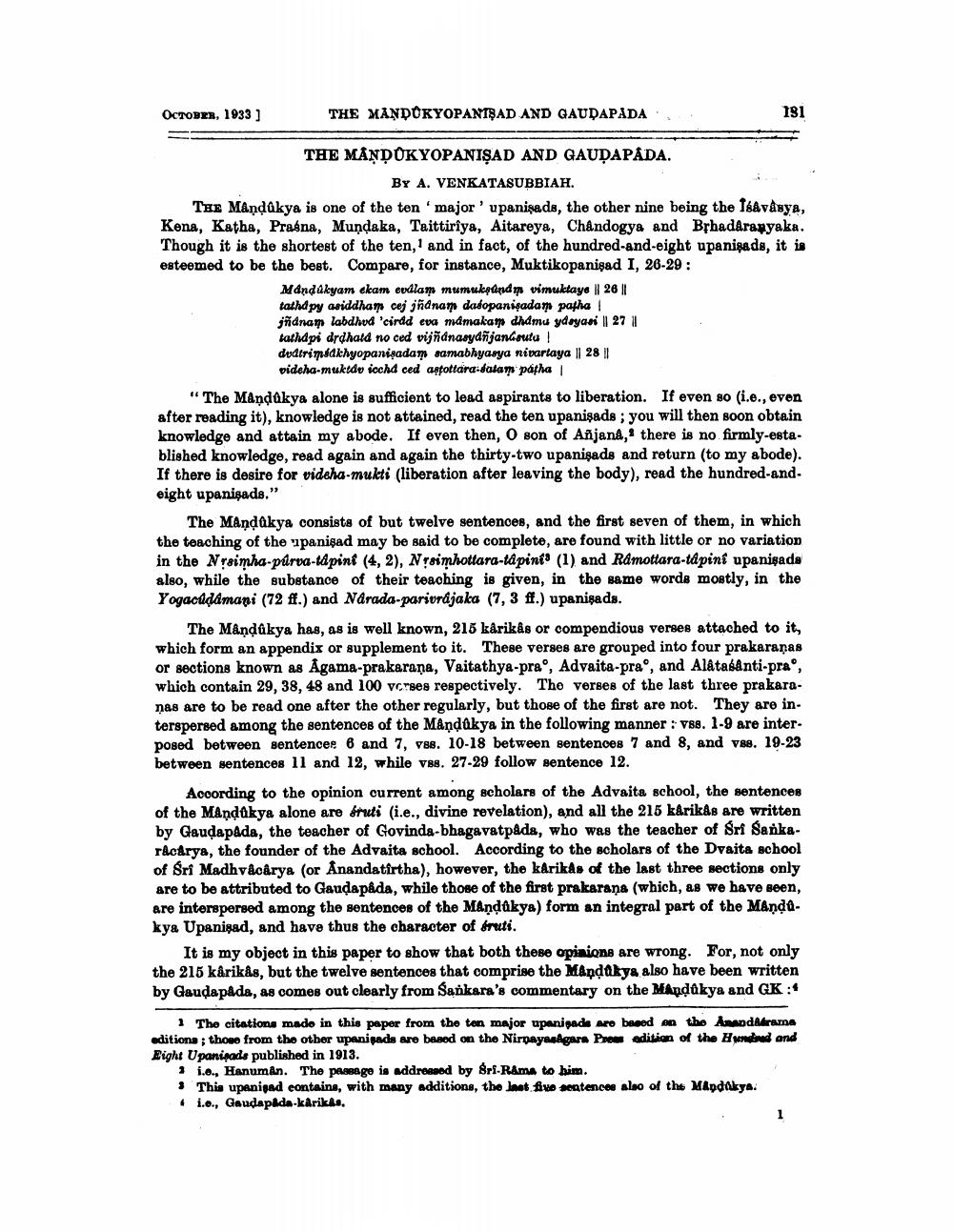________________
OCTOBER, 1933)
THE MANDOKYOPANTSAD AND GAUDAPADA'
181
THE MÅNDOKYOPANIŞAD AND GAUPAPADA.
BY A. VENKATASUBBIAH. The Mandukya is one of the ten 'major 'upanigads, the other nine being the Tsavasya, Kena, Katha, Praena, Mundaka, Taittiriya, Aitareya, Chandogya and BrhadArapyaka. Though it is the shortest of the ten, and in fact, of the hundred-and-eight upanigade, it is esteemed to be the best. Compare, for instance, Muktikopanigad I, 26-29 :
Måndakyam ekam evdlam mumsıkşund vimuktayo | 26 || tathd py asiddham cej jñanam dasopanişadam patha jħidnam labdhod 'cirad eva mamakam dhamu ydoyasi || 27 | tathapi drdhatd no ced vijñanasyañjanúoutu! dodtrimidkhyopanişadam samabhyasya nivarlaya || 28 |
videha-muktdv icchd ced astottara dalam patha "The Mandúkya alone is sufficient to lead aspirants to liberation. If even so (i.e., even after reading it), knowledge is not attained, read the ten upanişads ; you will then soon obtain knowledge and attain my abode. If even then, O son of Añjana,' there is no firmly-established knowledge, read again and again the thirty-two upanişads and return (to my abode). If there is desire for videha-mukti (liberation after leaving the body), read the hundred-andeight upanişads."
The Mandákya consists of but twelve sentences, and the first seven of them, in which the teaching of the panipad may be said to be complete, are found with little or no variation in the Nyaimha-purva-ta pini (4,2), Nrsimhottara-tapinis (1) and Råmottara-tdpinf upanişada also, while the substance of their teaching is given, in the same words mostly, in the Yogacddamani (72 ff.) and Narada-pariurájaka (7,3 ff.) upanişads.
The Mandukya has, as is well known, 215 kårikås or compendious verses attached to it, which form an appendix or supplement to it. These verses are grouped into four prakaranas or sections known as Agama-prakarana, Vaitathya-pra', Advaita-prao, and AlatasAnti-pra', which contain 29, 38, 48 and 100 vcrses respectively. The verses of the last three prakaraņas are to be read one after the other regularly, but those of the first are not. They are interspersed among the sentences of the Mândikya in the following manner : 188. 1-9 are interposed between sentencee 6 and 7, 788. 10-18 between sentences 7 and 8, and vse. 19-23 between sentences 11 and 12, while vs. 27-29 follow sentence 12.
According to the opinion current among scholars of the Advaita school, the sentences of the Mandokya alone are fruti (i.e., divine revelation), and all the 215 karikas are written by Gaudapada, the teacher of Govinda-bhagavatpada, who was the teacher of Sri SankarAcarya, the founder of the Advaita school. According to the scholars of the Dvaita school of Sri MadhyAcârya (or Anandatirtha), however, the karikas of the last three sections only are to be attributed to Gauda pada, while those of the first prakarans (which, as we have seen, are interspersed among the sentences of the Mandúkya) form an integral part of the Mandikya Upanipad, and have thus the character of fruti.
It is my object in this paper to show that both these opinions are wrong. For, not only the 215 kårikås, but the twelve sentences that comprise the Mandokya also have been written by Gaudapada, as comes out clearly from Sankara's commentary on the Mandukya and GK :*
1 The citations made in this paper from the ten major upanigads are based on the AnandArama editions ; those from the other upanipads are based on the Nirnayasagara Preus edition of the Hondared and Eight Upanipads published in 1913.
: 1.., Hanuman. The passage is addressed by Sri Rama to him. • This upanigad containe, with many additions, the last five sentence also of the Mapdokya. • i.o., Goudapkda-karikas




